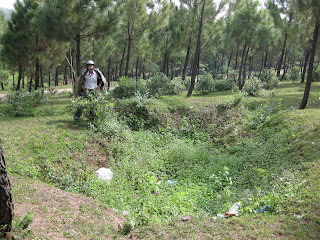



Hue is a bit less hectic than Hanoi but still deep in the grip of the horn-blowers, a noise that one's brain learns to screen out and ignore -- I stop noticing how my ears have pulled tight like fists, but at the moments you walk into a secluded courtyard, or emerge from a bus into the countryside the silence washes over like a cool, ethereal drink, lusciously the fists uncoil, the channels open, and not just the ears. We visit the emporers' tombs west of the city (great tombs are always placed west of cities, so that the sun sets over them), and the dense calm inside the walls is almost crippling, one wants so badly just to lie down and soak it in.
We were headed out of town on rented bikes, dilapidated big-wheeled cruisers that everyone rides there, and an older local on a scooter pulls uup next to us and strikes up a conversation. Whispy beard, North Face jacket. Now Vietnam, like most ppoor countries with a tourist trade, is a land of perpetual come-ons, but After a little while I felt that he was being genuine, and in any case spoke pretty good English (somewhat unusual in Vietnam) and had interesting things to say (unusual anywhere...). His name was Yung, pronounced like Jung the psycho-analyst, spelled Dung. Dung had fought in the war, for the South with American training, and it seemed he wanted to talk about it, as it was not something he could safely discuss with most Vietnamese. He had fought in this area for the U.S. Army, and he wanted to show us around the battlefields, which happened to include some impressive ruins and scenery. These included the tomb of the great king Thieu Trii, who (according to Dung) was a great king because he didn't place much burden on his people (esp. compared to the wild extravagances of Minh Mang's later reign, which we had seen the day before). One of the evidences of his munificence was the fact that the tomb itself, a round, walled zone about a hundred meters diameter, was left open to the public, for anyone desiring peace and quiet; Minh Mang's tomb was grander but entirely sealed; in fact, the doors were never opened, and his body was introduced to the tomb through an underground passage which was then filled. One can infer a lot about how many close-at-hand enemies each emperor had.
But the openness of the tomb had an unexpected consequence. Hue is close to the DMZ, the border staked out between North and South Vietnam by the UN, and so the region was the first to be attacked by northern soldiers. A group of these sneaked iinto the tomb and began using it as a sort of giant bunker, a base for guerrilla attacks; and Yung was part of the ARVN group who surrounded and stormed it. Mute witnesses to the violence, all the statues showed bullet holes and bits of shrapnel.
As he showed us a crater from a 300 kg bomb dropped from a B-52, (seen in the picture), I began to see that for Dung the war had been a terrifying experience but also an exhilarating, world-opening one.
I realized that most of my media experience perception of Vietnam has been through war fiilms -- Apocalyse Now, Full Metal Jacket, Platoon. Now I had to expand my notion of the war as a tragic, bloody blunder, a terrible mistake; and instead see that even something as generally destructive as a war can have a completely benign side, that some of the inadvertent participants had ultimately enjoyed it, even treasured the experience, at least in retrospect. Weird, but the kind of thing you learn from traveling -- the world is much richer, more complex than you can imagine.

No comments:
Post a Comment